Peugeot 308 CC 2013.5 Owner's Manual - RHD (UK. Australia)
Manufacturer: PEUGEOT, Model Year: 2013.5, Model line: 308 CC, Model: Peugeot 308 CC 2013.5Pages: 268, PDF Size: 16.54 MB
Page 111 of 268
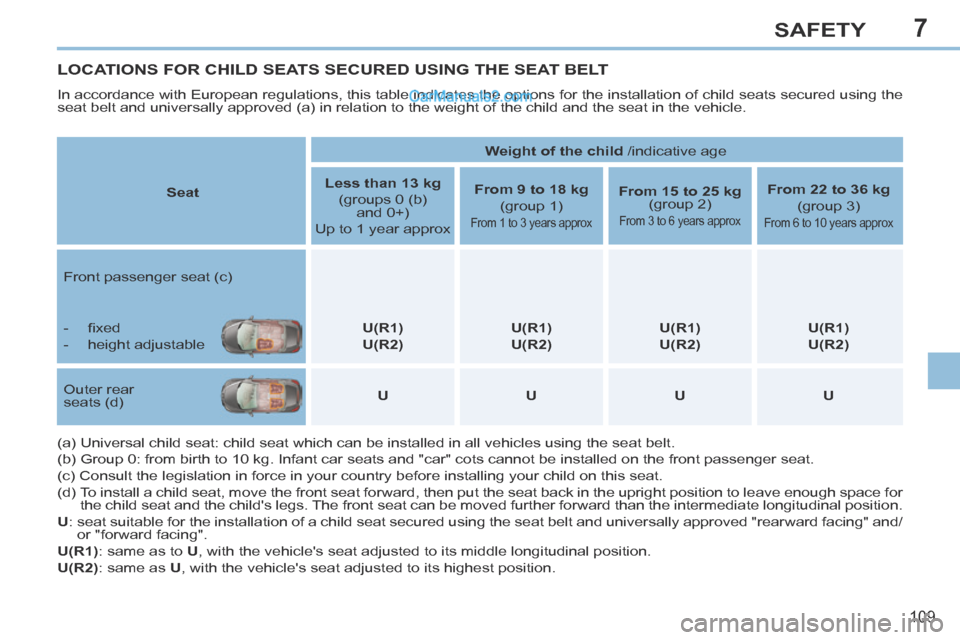
7
109
SAFETY
LOCATIONS FOR CHILD SEATS SECURED USING THE SEAT BELT
In accordance with European regulations, this table indicates the option\
s for the installation of child seats secured using the
seat belt and universally approved (a) in relation to the weight of th\
e child and the seat in the vehicle.
(a) Universal child seat: child seat which can be installed in all veh\
icles using the seat belt.
(b) Group 0: from birth to 10 kg. Infant car seats and "car" cots cann\
ot be installed on the front passenger seat.
(c) Consult the legislation in force in your country before installing\
your child on this seat.
(d) To install a child seat, move the front seat forward, then put the seat b\
ack in the upright position to leave enough space for the child seat and the child's legs. The front seat can be moved further forward than the intermediate longitudinal position.
U : seat suitable for the installation of a child seat secured using the seat belt and universally approved "rearward facing" and/ or "forward facing".
U(R1) : same as to U , with the vehicle's seat adjusted to its middle longitudinal position. \
U(R2) : same as U , with the vehicle's seat adjusted to its highest position.
Seat
Weight of the child /indicative age
Less than 13 kg (groups 0 (b) and 0+)
Up to 1 year approx From 9 to 18 kg
(group 1)
From 1 to 3 years approx
From 15 to 25 kg
(group 2)
From 3 to 6 years approx
From 22 to 36 kg
(group 3)
From 6 to 10 years approx
Front passenger seat (c)
- fi x e d
- height adjustable U(R1)
U(R2) U(R1)
U(R2) U(R1)
U(R2) U(R1)
U(R2)
Outer rear
seats (d) U
U U U
Page 112 of 268

7
!
i
11 0
SAFETY
"ISOFIX" MOUNTINGS
Your vehicle has been approved to the
latest ISOFIX regulations .
The seats represented below are fi tted
with these regulation ISOFIX mountings:
These are two rings A for each seat, lo-
cated between the seat back and seat
cushion of the vehicle's seat, indicated
by a label.
The incorrect installation of a child
seat in a vehicle compromises the
protection of the child in the event
of a collision. Observe in full the fi tting instruc-
tions in the installation handbook
provided with the child seat.
For installing ISOFIX child seats
in your vehicle, refer to the table
showing the locations for fi tting
ISOFIX child seats.
These rings are located behind covers.
For access to them:
insert the ignition key in the cut-out
in the cover,
pull it forwards to unclip it and then fold it down.
This ISOFIX mounting system provides
reliable, safe and fast fi tting of the child
seat in your vehicle.
The ISOFIX child seats are fi tted with
two latches which are secured easily on
these rings A .
Page 113 of 268
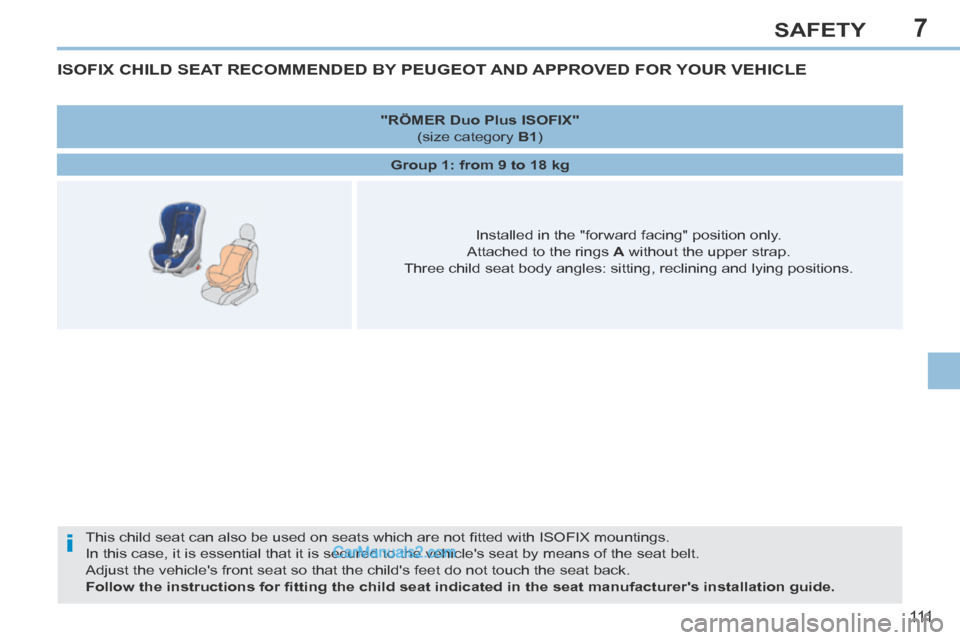
7
i
111
SAFETY
ISOFIX CHILD SEAT RECOMMENDED BY PEUGEOT AND APPROVED FOR YOUR VEHICLE
This child seat can also be used on seats which are not fi tted with ISOFIX mountings.
In this case, it is essential that it is secured to the vehicle's seat b\
y means of the seat belt.
Adjust the vehicle's front seat so that the child's feet do not touch th\
e seat back.
Follow the instructions for fi tting the child seat indicated in the seat manufacturer's installation guide. "RÖMER Duo Plus ISOFIX"
(size category B1 )
Group 1: from 9 to 18 kg
Installed in the "forward facing" position only.
Attached to the rings A without the upper strap.
Three child seat body angles: sitting, reclining and lying positions.
Page 114 of 268
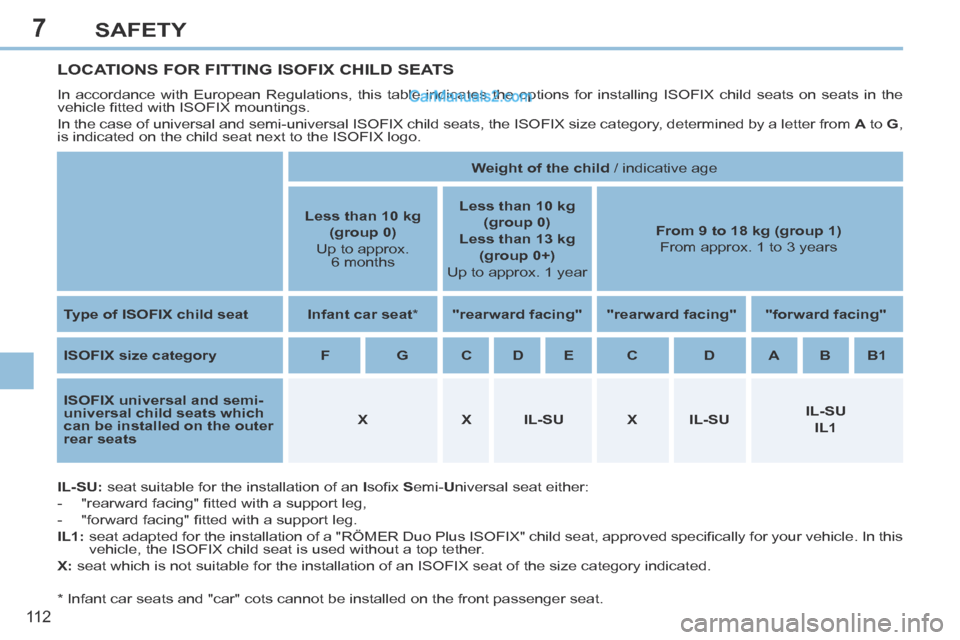
7
11 2
SAFETY
LOCATIONS FOR FITTING ISOFIX CHILD SEATS
In accordance with European Regulations, this table indicates the option\
s for installing ISOFIX child seats on seats in the
vehicle fi tted with ISOFIX mountings.
In the case of universal and semi-universal ISOFIX child seats, the ISOF\
IX size category, determined by a letter from A to G ,
is indicated on the child seat next to the ISOFIX logo.
IL-SU: seat suitable for the installation of an I sofi x S emi- U niversal seat either:
- "rearward facing" fi tted with a support leg,
- "forward facing" fi tted with a support leg.
IL1: seat adapted for the installation of a "RÖMER Duo Plus ISOFIX" child seat, approved specifi cally for your vehicle. In this vehicle, the ISOFIX child seat is used without a top tether.
X: seat which is not suitable for the installation of an ISOFIX seat of th\
e size category indicated.
Weight of the child / indicative age
Less than 10 kg (group 0)
Up to approx. 6 months Less than 10 kg
(group 0)
Less than 13 kg
(group 0+)
Up to approx. 1 year From 9 to 18 kg (group 1)
From approx. 1 to 3 years
Type of ISOFIX child seat Infant car seat * " rearward facing" " rearward facing" "forward facing"
ISOFIX size category F G C D E C D A B B1
ISOFIX universal and semi-
universal child seats which
can be installed on the outer
rear seats X
X IL-SU X IL-SU IL-SU
IL1
* Infant car seats and "car" cots cannot be installed on the front passeng\
er seat.
Page 115 of 268
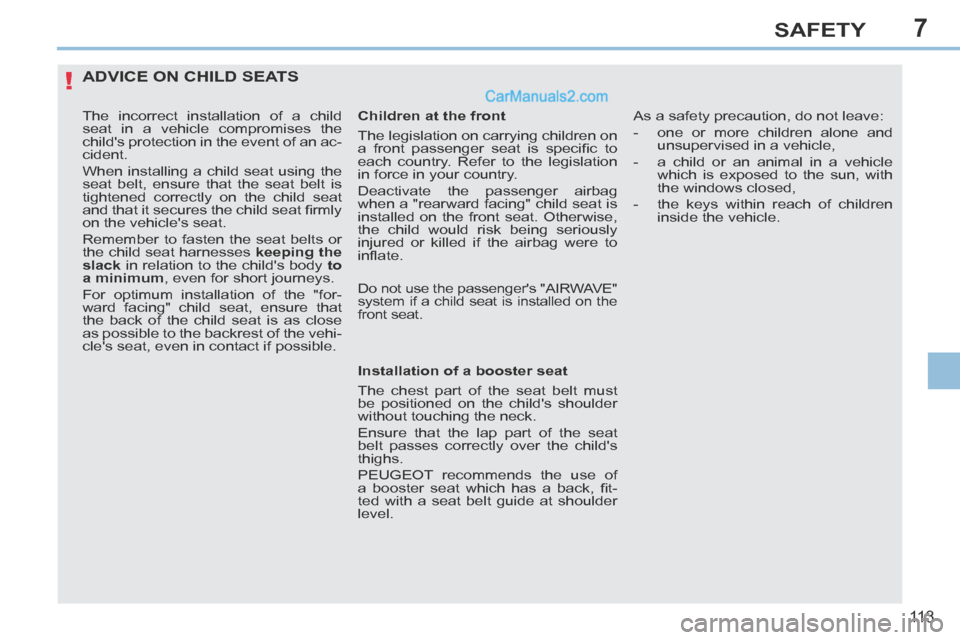
7
!
11 3
SAFETY
ADVICE ON CHILD SEATS
The incorrect installation of a child
seat in a vehicle compromises the
child's protection in the event of an ac-
cident.
When installing a child seat using the
seat belt, ensure that the seat belt is
tightened correctly on the child seat
and that it secures the child seat fi rmly
on the vehicle's seat.
Remember to fasten the seat belts or
the child seat harnesses keeping the
slack in relation to the child's body to
a minimum , even for short journeys.
For optimum installation of the "for-
ward facing" child seat, ensure that
the back of the child seat is as close
as possible to the backrest of the vehi-
cle's seat, even in contact if possible. Children at the front
The legislation on carrying children on
a front passenger seat is specifi c to
each country. Refer to the legislation
in force in your country.
Deactivate the passenger airbag
when a "rearward facing" child seat is
installed on the front seat. Otherwise,
the child would risk being seriously
injured or killed if the airbag were to
infl ate.
As a safety precaution, do not leave:
- one or more children alone and
unsupervised in a vehicle,
- a child or an animal in a vehicle which is exposed to the sun, with
the windows closed,
- the keys within reach of children inside the vehicle.
Installation of a booster seat
The chest part of the seat belt must
be positioned on the child's shoulder
without touching the neck.
Ensure that the lap part of the seat
belt passes correctly over the child's
thighs.
PEUGEOT recommends the use of
a booster seat which has a back, fi t-
ted with a seat belt guide at shoulder
level.
Do not use the passenger's "AIRWAVE"
system if a child seat is installed on the
front seat.
Page 116 of 268
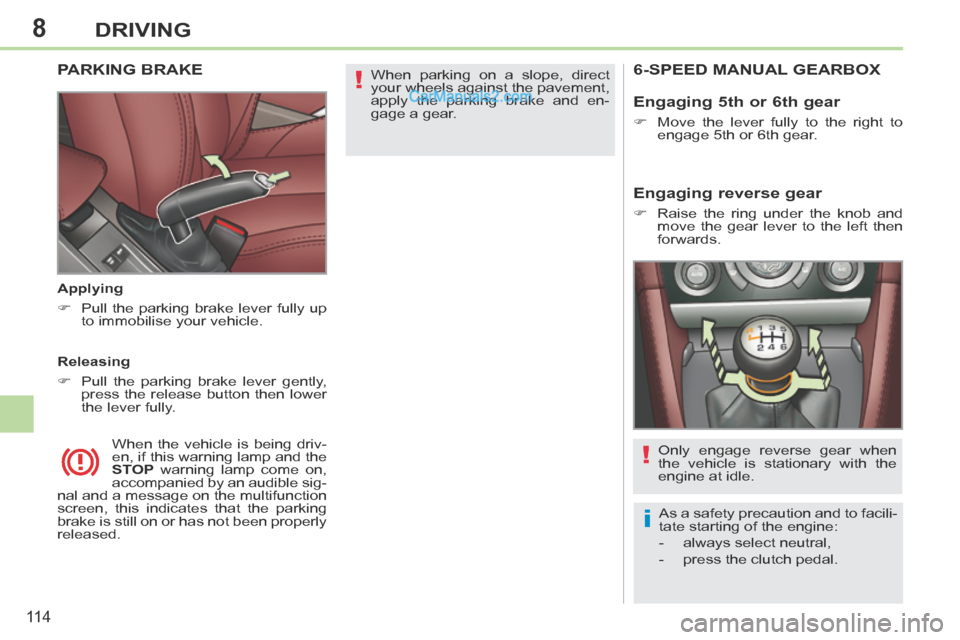
8
!
i
!
11 4
DRIVING
When parking on a slope, direct
your wheels against the pavement,
apply the parking brake and en-
gage a gear. PARKING BRAKE
Applying
Pull the parking brake lever fully up to immobilise your vehicle.
When the vehicle is being driv-
en, if this warning lamp and the
STOP warning lamp come on,
accompanied by an audible sig-
nal and a message on the multifunction
screen, this indicates that the parking
brake is still on or has not been properly
released. Releasing
Pull the parking brake lever gently, press the release button then lower
the lever fully.
6-SPEED MANUAL GEARBOX
As a safety precaution and to facili-
tate starting of the engine:
- always select neutral,
- press the clutch pedal.
Only engage reverse gear when
the vehicle is stationary with the
engine at idle.
Engaging reverse gear
Raise the ring under the knob and
move the gear lever to the left then
forwards.
Engaging 5 th or 6 th gear
Move the lever fully to the right to engage 5 th or 6 th gear.
Page 117 of 268
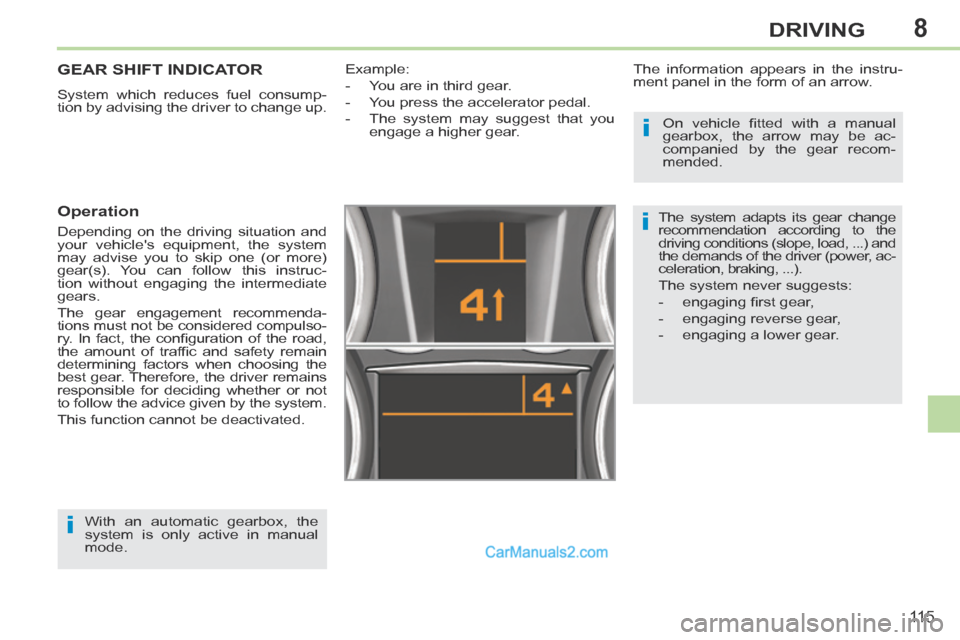
8
i
i
i
11 5
DRIVING
GEAR SHIFT INDICATOR
System which reduces fuel consump-
tion by advising the driver to change up.
Operation
Depending on the driving situation and
your vehicle's equipment, the system
may advise you to skip one (or more)
gear(s). You can follow this instruc-
tion without engaging the intermediate
gears.
The gear engagement recommenda-
tions must not be considered compulso-
ry. In fact, the confi guration of the road,
the amount of traffi c and safety remain
determining factors when choosing the
best gear. Therefore, the driver remains
responsible for deciding whether or not
to follow the advice given by the system.
This function cannot be deactivated. The information appears in the instru-
ment panel in the form of an arrow.
The system adapts its gear change
recommendation according to the
driving conditions (slope, load, ...) and
the demands of the driver (power, ac-
celeration, braking, ...).
The system never suggests:
- engaging fi rst gear,
- engaging reverse gear,
- engaging a lower gear.
Example:
- You are in third gear.
- You press the accelerator pedal.
- The system may suggest that you
engage a higher gear.
With an automatic gearbox, the
system is only active in manual
mode. On vehicle fi tted with a manual
gearbox, the arrow may be ac-
companied by the gear recom-
mended.
Page 118 of 268

8
11 6
DRIVING
"PORSCHE TIPTRONIC SYSTEM" AUTOMATIC GEARBOX
Six speed automatic gearbox which of-
fers a choice between the comfort of
fully automatic operation, enhanced by
sport and snow programmes, or manual
gear changing.
There are two driving modes:
- automatic operation for electronic management of the gears by the
gearbox, with the sport programme
for a more dynamic driving style or
the snow programme to facilitate
driving when grip is poor.
- manual operation for sequential changing of the gears by the driver.
Gear lever positions
P. Park.
- Immobilisation of the vehicle, park- ing brake on or off.
- Starting the engine.
R. Reverse.
- Reversing manoeuvres, vehicle sta- tionary, engine at idle.
N. Neutral.
- Immobilisation of the vehicle, park- ing brake on.
- Starting the engine.
D. Automatic operation.
M. + / - Manual operation with sequen- tial changing of the six gears.
Press forwards to change up through the gears.
or
Press rearwards to change down through the gears.
Displays in the instrument panel
When you move the lever in the gate
to select a position, the corresponding
symbol is displayed in the instrument
panel.
P. Park
R. Reverse
N. Neutral
D1... D6. Drive (Automatic driving)
S. Sport programme
. Snow programme
M1... M6. Manual (Sequential driving)
-. Invalid value during manual operation
Gear selection gate
1. Gear lever.
2. Button "S" (sport) .
3. Button " " (snow) .
Page 119 of 268
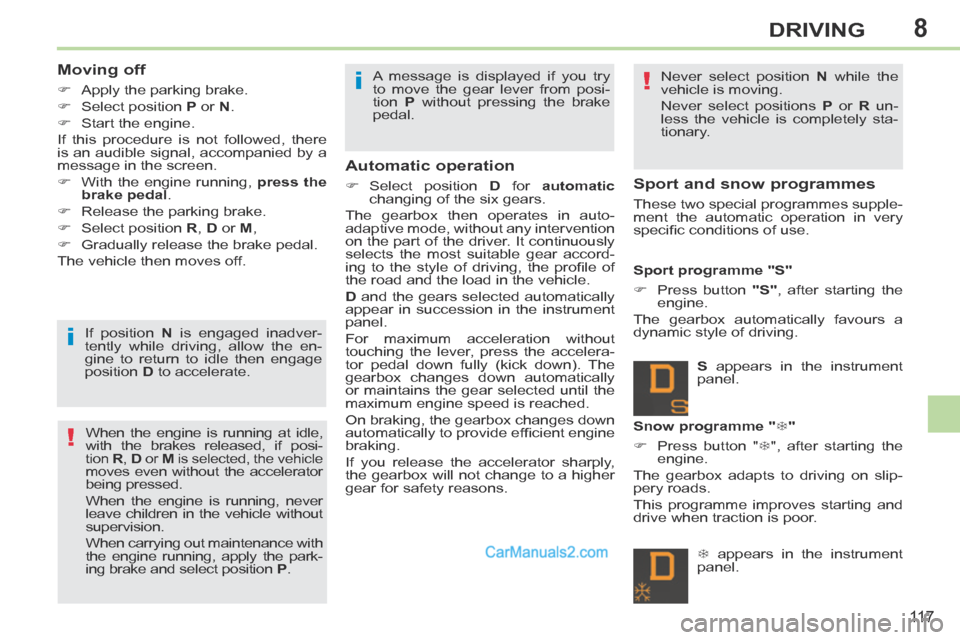
8
!
!
i
i
11 7
DRIVING
Moving off
Apply the parking brake.
Select position P or N .
Start the engine.
If this procedure is not followed, there
is an audible signal, accompanied by a
message in the screen.
With the engine running, press the brake pedal.
Release the parking brake.
Select position R , D or M ,
Gradually release the brake pedal.
The vehicle then moves off.
If position N is engaged inadver-
tently while driving, allow the en-
gine to return to idle then engage
position D to accelerate.
When the engine is running at idle,
with the brakes released, if posi-
tion R , D or M is selected, the vehicle moves even without the accelerator
being pressed.
When the engine is running, never
leave children in the vehicle without
supervision.
When carrying out maintenance with
the engine running, apply the park-
ing brake and select position P . A message is displayed if you try
to move the gear lever from posi-
tion
P without pressing the brake
pedal.
Automatic operation
Select position D for automatic
changing of the six gears.
The gearbox then operates in auto-
adaptive mode, without any intervention
on the part of the driver. It continuously
selects the most suitable gear accord-
ing to the style of driving, the profi le of
the road and the load in the vehicle.
D and the gears selected automatically
appear in succession in the instrument
panel.
For maximum acceleration without
touching the lever, press the accelera-
tor pedal down fully (kick down). The
gearbox changes down automatically
or maintains the gear selected until the
maximum engine speed is reached.
On braking, the gearbox changes down
automatically to provide effi cient engine
braking.
If you release the accelerator sharply,
the gearbox will not change to a higher
gear for safety reasons. Never select position
N while the
vehicle is moving.
Never select positions P or R un-
less the vehicle is completely sta-
tionary. Sport and snow programmes
These two special programmes supple-
ment the automatic operation in very
specifi c conditions of use.
Sport programme "S"
Press button "S" , after starting the
engine.
The gearbox automatically favours a
dynamic style of driving.
S appears in the instrument
panel.
Snow programme " "
Press button " ", after starting the
engine.
The gearbox adapts to driving on slip-
pery roads.
This programme improves starting and
drive when traction is poor.
appears in the instrument
panel.
Page 120 of 268
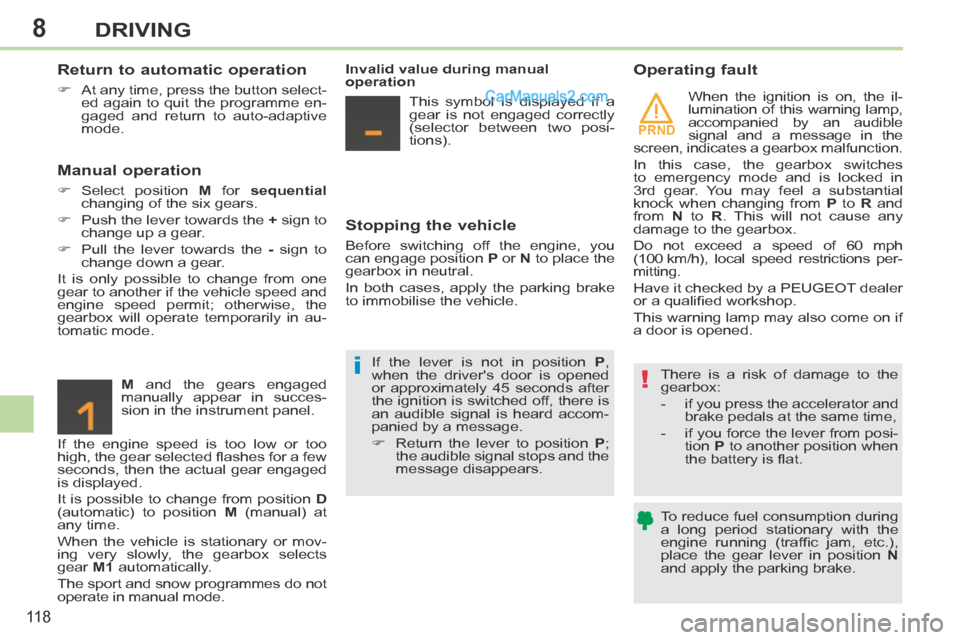
8
PRND
!i
11 8
DRIVING
Return to automatic operation
At any time, press the button select-ed again to quit the programme en-
gaged and return to auto-adaptive
mode.
Manual operation
Select position M for sequential
changing of the six gears.
Push the lever towards the + sign to
change up a gear.
Pull the lever towards the - sign to
change down a gear.
It is only possible to change from one
gear to another if the vehicle speed and
engine speed permit; otherwise, the
gearbox will operate temporarily in au-
tomatic mode.
M and the gears engaged
manually appear in succes-
sion in the instrument panel.
If the engine speed is too low or too
high, the gear selected fl ashes for a few
seconds, then the actual gear engaged
is displayed.
It is possible to change from position D
(automatic) to position M (manual) at
any time.
When the vehicle is stationary or mov-
ing very slowly, the gearbox selects
gear M1 automatically.
The sport and snow programmes do not
operate in manual mode. Invalid value during manual
operation
This symbol is displayed if a
gear is not engaged correctly
(selector between two posi-
tions).
Stopping the vehicle
Before switching off the engine, you
can engage position P or N to place the
gearbox in neutral.
In both cases, apply the parking brake
to immobilise the vehicle.
Operating fault
There is a risk of damage to the
gearbox:
- if you press the accelerator and brake pedals at the same time,
- if you force the lever from posi- tion P to another position when
the battery is fl at.
To reduce fuel consumption during
a long period stationary with the
engine running (traffi c jam, etc.),
place the gear lever in position N
and apply the parking brake.
If the lever is not in position
P ,
when the driver's door is opened
or approximately 45 seconds after
the ignition is switched off, there is
an audible signal is heard accom-
panied by a message.
Return the lever to position P ;
the audible signal stops and the
message disappears. When the ignition is on, the il-
lumination of this warning lamp,
accompanied by an audible
signal and a message in the
screen, indicates a gearbox malfunction.
In this case, the gearbox switches
to emergency mode and is locked in
3rd gear. You may feel a substantial
knock when changing from P to R and
from N to R . This will not cause any
damage to the gearbox.
Do not exceed a speed of 60 mph
(100 km/h), local speed restrictions per-
mitting.
Have it checked by a PEUGEOT dealer
or a qualifi ed workshop.
This warning lamp may also come on if
a door is opened.